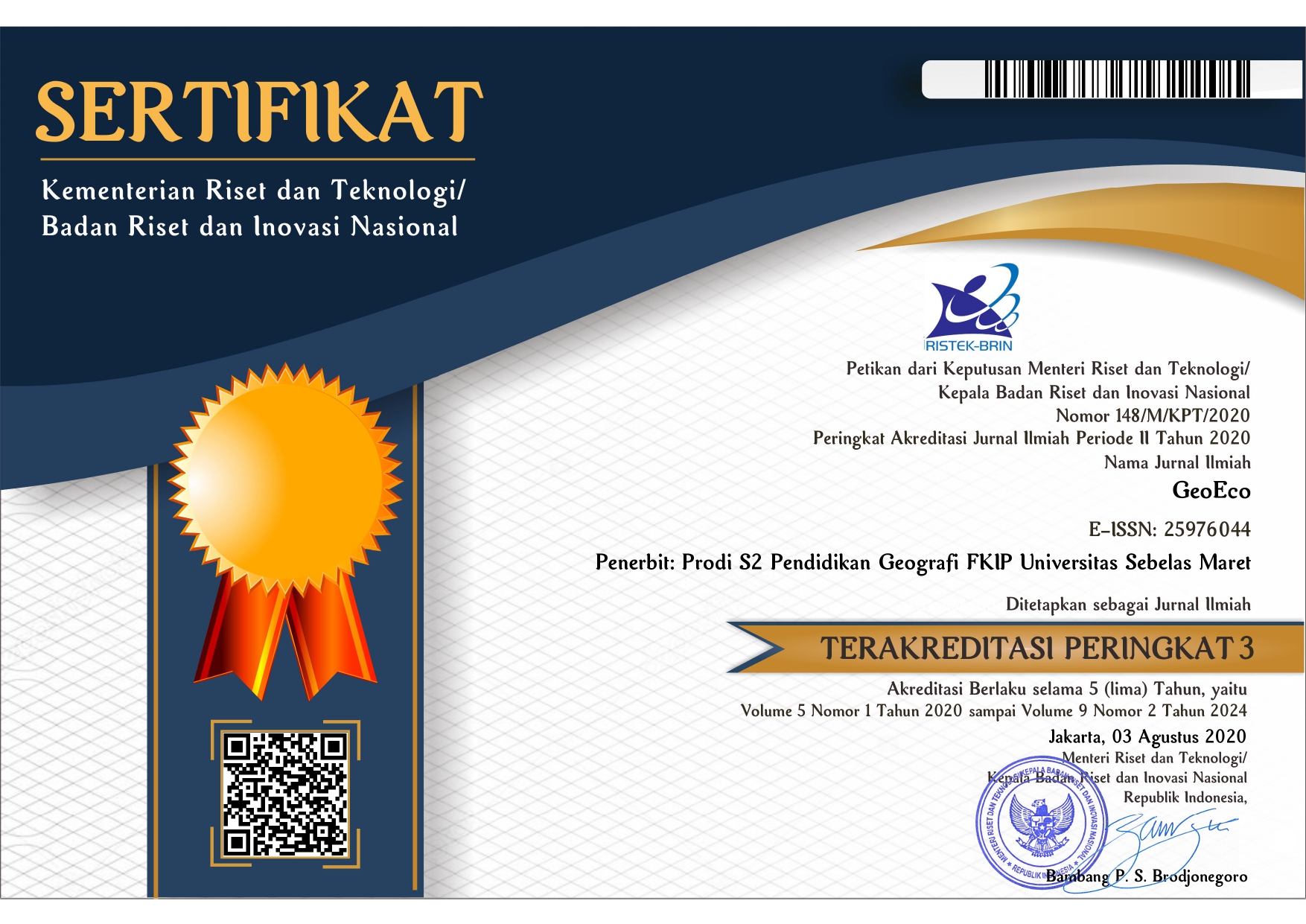DETERMINING THE LOCATION OF LAND SUBSIDENCE OBSERVATION POINTS BASED ON LITHOLOGICAL DATA AND LAND COVER CHANGES IN LAMPUNG PROVINCE
Abstract
Land subsidence is a phenomenon that always occurs due to natural factors as well as human actions. Land subsidence has an even impact on all fronts. Land subsidence occurs continuously, therefore it is necessary to observe the phenomenon of land subsidence periodically using the GNSS method, which requires a benchmark that serves as a reference point for observation. With the need for a new benchmark devoted to observing land subsidence, it is necessary to do spatial modeling which is useful for finding out the suitability of the location where the subsidence observation point will be made. Spatial modeling was carried out using land cover data and lithology type to then be given weight and score and determined the soil movement vulnerability class into three, namely low class, medium class, and high class. The results of the spatial modeling of subsidence vulnerability show that the area12292.60 square kilometers is low grade, 20230.64 square kilometers represents medium class and 540.32 square kilometers is high class. Based on these results, the planning of the location of new observation points was carried out in areas with moderate to high levels of vulnerability with a total of 87 points scattered throughout the cities in Lampung.
Keywords
Full Text:
PDFReferences
Abidin, H. Z., Andreas, H., Gumilar, I., Azdan, M. D., Ali, F., & Brinkman, J. . (2016). Disaster Risk Reduction of Land Subsidence in Jakarta. The 2nd International Workshop on Coastal Subsidence, May.
Al Akbar, T. O., Prasetyo, Y., & Wijaya, A. (2015). ANALISIS DAMPAK PENURUNAN MUKA TANAH TERHADAP TINGKAT EKONOMI MENGGUNAKAN KOMBINASI METODE DINSAR DAN SIG (STUDI KASUS : KOTA SEMARANG). Jurnal Geodesi Undip, 4(4).
Andreas, H., Zainal Abidin, H., Anggreni Sarsito, D., Meilano, I., & Susilo, S. (2019). Investigating the tectonic influence to the anthropogenic subsidence along northern coast of Java Island Indonesia using GNSS data sets. E3S Web of Conferences, 94. https://doi.org/10.1051/e3sconf/20199404005
Andreas, H., Zainal Abidin, H., Gumilar, I., Purnama Sidiq, T., Anggreni Sarsito, D., & Pradipta, D. (2019). On the acceleration of land subsidence rate in Semarang City as detected from GPS surveys. E3S Web of Conferences, 94. https://doi.org/10.1051/e3sconf/20199404002
Bates, R. L., & Jackson, J. A. (1987). Glossary of Geology. Third edition. Glossary of Geology. Third Edition.
Fiantis, D. (2017). MORFOLOGI DAN KLASIFIKASI TANAH. In MORFOLOGI DAN KLASIFIKASI TANAH. https://doi.org/10.25077/car.4.2
Hu, B., Chen, J., & Zhang, X. (2019). Monitoring the land subsidence area in a coastal urban area with InSAR and GNSS. Sensors (Switzerland), 19(14). https://doi.org/10.3390/s19143181
Hutabarat, L. E. (2017). Studi Penurunan Muka Tanah (Land Subsidence) Akibat Pengambilan Air Tanah Berlebihan Di DKI Jakarta. In Kumpulan Karya Ilmiah Dosen Universitas Kristen Indonesia Delapan Windu.
Isnaeni, Y., & Farda, N. M. (2020). Analisis Penurunan Muka Tanah Sebagian Kota Semarang Tahun 2017-2019 Menggunakan Citra Sentinel-1A dan Teknik Different Interferometry Synthetic Apertare Radar (D. Jurnal Bumi Indonesia, IX(3).
Nurhamidah, N., Rusman, B., Istijono, B., Hakam, A., & Junaidi, A. (2018). Monitoring and empirical modelling for organic soil subsidence estimation in Sumatra. International Journal on Advanced Science, Engineering and Information Technology, 8(5). https://doi.org/10.18517/ijaseit.8.5.3515
Rahn, P. H., & Onak, A. (1991). Subsidence—occurrence, prediction and control. Engineering Geology, 31(1). https://doi.org/10.1016/0013-7952(91)90060-x
Setyadi, B., & Rustadi, R. (2020). Analisis Penurunan Muka Tanah dengan Small Baseline Subset Differential SAR Interferograms di Kota Bandar Lampung. Jurnal Geofisika Eksplorasi, 5(2). https://doi.org/10.23960/jge.v5i2.27
Sophian, R. I. (2010). Penurunan Muka Tanah di Kota-Kota Besar Pesisir Pantai Utara Jawa (Studi Kasus: Kota Semarang). Bulletin of Scientific Contribution, 8(1).
Sudarto, L. (2012). Prediksi Penurunanmuka Air Tanah Akibat Pemompaan Di Daerah Jogonalan Klaten Jawa Tengah. Seminar Nasional Informatika, 2012(ISSN: 1979-2328).
Treman, W. (2016). Geologi Dasar. Kuhd, 9.
Whittaker, B. N., & Reddish, D. J. (1990). Subsidence: occurrence, prediction and control (Developments in Geotechnical Engineering, 56). International Journal of Rock Mechanics and Mining Sciences & Geomechanics Abstracts, 27(2). https://doi.org/10.1016/0148-9062(90)95372-8
Widodo, J., Herlambang, A., Sulaiman, A., Razi, P., Yohandri, Perissin, D., Kuze, H., & Sri Sumantyo, J. T. (2019). Land subsidence rate analysis of Jakarta Metropolitan Region based on D-InSAR processing of Sentinel data C-Band frequency. Journal of Physics: Conference Series, 1185(1). https://doi.org/10.1088/1742-6596/1185/1/012004
Yastika, P. E., Shimizu, N., Tanaka, T., & Osawa, T. (2017). Multi-temporal Analysis for Differential Interferometry Synthetic Aperture Radar (D-InSAR) and Its Application to Monitoring Land Surface Displcements. International Journal of Environment and Geosciences, 1(1). https://doi.org/10.24843/ijeg.2017.v01.i01.p01
Yuhanafia, N., & Andreas, H. (2017). PERTAMBAHAN ESTIMASI KERUGIAN EKONOMI AKIBAT BANJIR DENGAN PENGARUH PENURUNAN TANAH DI JAKARTA. Jurnal Geografi Gea, 17(2). https://doi.org/10.17509/gea.v17i2.7490
Yuwono, B. D., Prasetyo, Y., & Islama, L. J. F. (2018). Investigation of Potential Landsubsidence using GNSS CORS UDIP and DinSAR, Sayung, Demak, Indonesia. IOP Conference Series: Earth and Environmental Science, 123(1). https://doi.org/10.1088/1755-1315/123/1/012005
Zaenudin, A., Darmawan, I. G. B., Armijon, Minardi, S., & Haerudin, N. (2018). Land subsidence analysis in Bandar Lampung City based on InSAR. Journal of Physics: Conference Series, 1080(1). https://doi.org/10.1088/1742-6596/1080/1/012043Refbacks
- There are currently no refbacks.












.png)

